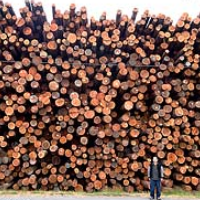Loggers Win! U.S. Forest Service Gives the Go to Clear Remains of the Rim Fire
 (photo: Richard Wong)
(photo: Richard Wong)
Logging companies are breaking out the chain saws in what is left of the burned portions of the Sierra Mountains where the Rim Fire raged last summer.
The U.S. Forest Service announced on Wednesday it had rejected environmentalist calls to let the 15,000 acres of ravaged terrain in question recover naturally and approved plans to log the area. Trees deemed a threat to the public will be cleared along another 17,706 square miles along roads.
California Forestry Association President David Bischel praised the decision by Stanislaus National Forest Supervisor Susan Skalski to allow the heavily contested logging. She acted under emergency rules that cannot be appealed administratively and said, “I realize that my decision will not please every member of the public.”
Roger that.
Chad Hanson, director of the John Muir Project of Earth Island Institute, called her decision an “ecological travesty.” Hanson, who told the Associated Press he was considering a court challenge, said, “It’s basically an extinction plan for the California spotted owl.”
The massive 69-day Rim Fire burned 275,000 acres in Stanislaus Forest, Yosemite National Park and on private land, prompting quick calls to send heavy equipment into the woods to log remaining healthy trees in burned areas. Representative Tom McClintock, a Republican who represents the area, pushed hard for legislation last September to immediately start logging but failed.
He was critical of the department for taking so long. “They’ve taken so much time I’d be surprised they get any bids at all,” McClintock told AP. “If they did, it’s a fraction of the acreage that could have been salvaged.”
Judging by Bischel’s enthusiasm, there will be bidders.
Supporters of the logging—the Los Angeles Times says that includes some birding clubs, Indian tribes and local conservationists—argue the wood is needed for worthwhile projects; timber companies and the local communities would profit from the activity; dead and dying trees would be put to good use; public roads would be protected from falling trees; fungus and destructive critters would be thwarted; and thinning of the forests would reduce the danger of future fire.
Hanson and other environmentalists argued that it is important to let the forest go through a natural recovery. In an article for Salon, he laid out the process of “ecological restoration.” In this case, a formerly mature forest would be transformed into a “snag forest” of “standing fire-killed trees, or ‘snags,’ patches of native fire-following shrubs, downed logs, colorful flowers, and dense pockets of natural conifer regeneration.”
What follows is an evolving habitat that involves black-back woodpeckers (a keystone species) carving out nesting cavities, beetle larvae, flowering shrubs attracting insects, and the return of raptors (like owls), deer, small mammals and bears.
Two hundred scientists signed a letter (pdf) agreeing with Hanson’s assessment and warned of the dangers logging the area will bring:
“Numerous studies also document the cumulative impacts of post-fire logging on natural ecosystems, including the elimination of bird species . . . , compaction of soils, elimination of biological legacies (snags and downed logs) . . . , spread of invasive species, accumulation of logging slash that can add to future fire risks, increased mortality of conifer seedlings and other important re-establishing vegetation (from logs dragged uphill in logging operations), and increased chronic sedimentation in streams due to the extensive road network and runoff from logging operations.”
Despite McClintock’s skepticism, one logging official told the Times that $100 million worth of timber could be hauled out of the forest. That would be the equivalent of all the timber logged in all of California’s national forests last year.
–Ken Broder
To Learn More:
Feds Allow Logging after Huge California Wildfire (by Scott Smith, Associated Press)
Rim Fire’s “Ghost” Trees to Be Logged, U.S. Forest Service Decides (by Diana Marcum, Los Angeles Times)
U.S. Forest Service Wants to Log Burned Rim Fire Area (by Ken Broder, AllGov California)
- Top Stories
- Controversies
- Where is the Money Going?
- California and the Nation
- Appointments and Resignations
- Unusual News
- Latest News
- California Forbids U.S. Immigration Agents from Pretending to be Police
- California Lawmakers Urged to Strip “Self-Dealing” Tax Board of Its Duties
- Big Oil’s Grip on California
- Santa Cruz Police See Homeland Security Betrayal in Use of Gang Roundup as Cover for Immigration Raid
- Oil Companies Face Deadline to Stop Polluting California Groundwater





